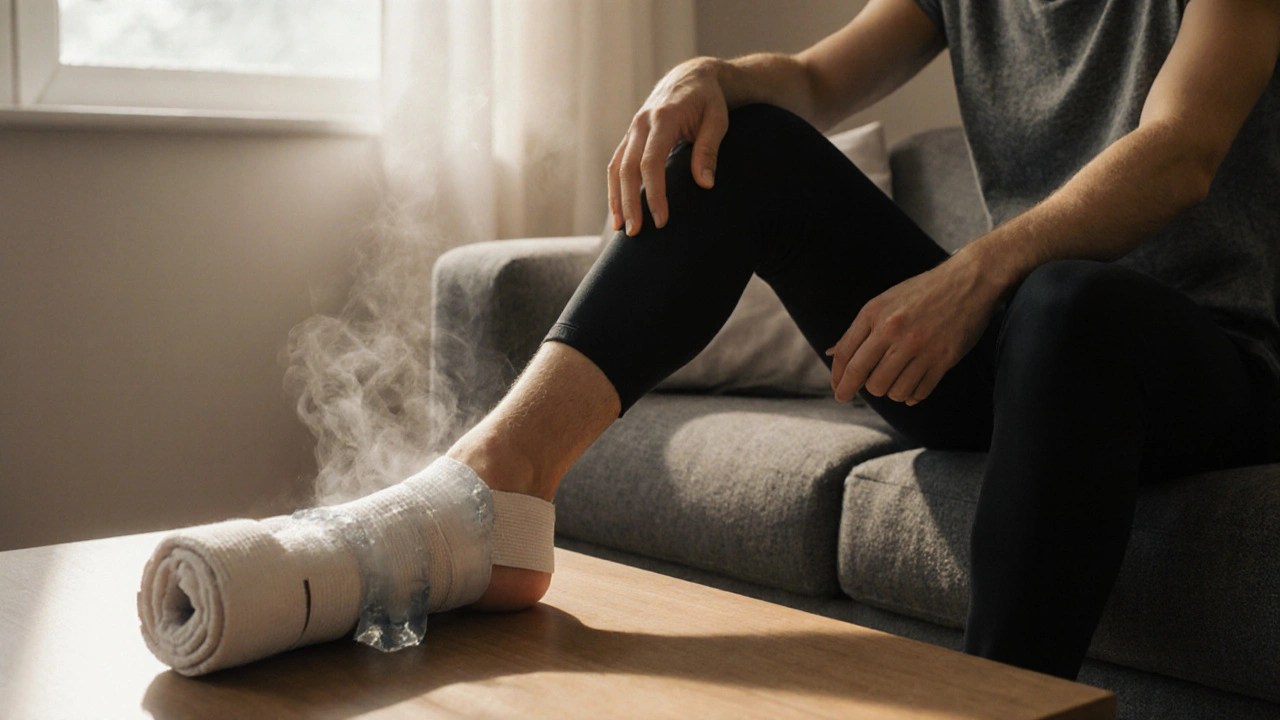Sprain Recovery Progress Tracker
Select your sprain severity to begin tracking your recovery:
Got a sprain and wondering how to get back moving without blowing the injury out of proportion? The good news is you don’t have to wait forever or jump straight into high‑intensity cardio. With a clear plan that respects the body’s healing timeline, you can regain strength, mobility, and confidence while keeping the risk of re‑injury low.
TL;DR
- Use the RICE method for the first 48‑72hours.
- Begin gentle range‑of‑motion work after swelling subsides.
- Progress to isometric then light resistance exercises.
- Add balance and proprioception drills before sport‑specific moves.
- Stop if pain rises above a mild ache or swelling returns.
Understanding a Sprain
Sprain is a stretching or tearing of ligaments surrounding a joint. Ligaments act like the band‑like stitches that hold bones together, so when they’re overstretched the joint becomes unstable.
The severity is graded from I (microscopic tears) to III (complete rupture). A grade‑I sprain may heal in a week, while grade‑III can need weeks of rehab or even surgery. Knowing your grade helps you set realistic expectations for when you can safely resume exercise after injury.
Phase1 - Acute Care (0-72hours)
The first priority is to limit swelling and protect the joint. The classic RICE protocol Rest, Ice, Compression, Elevation does exactly that.
- Rest: Avoid weight‑bearing or any movement that hurts.
- Ice: Apply a cold pack for 15‑20minutes every 2‑3hours.
- Compression: Use an elastic wrap to keep swelling down, but not so tight it cuts circulation.
- Elevation: Keep the injured limb above heart level whenever possible.
During this window, keep your overall activity low‑impact - think walking with a cane or using a stationary bike with minimal resistance if the joint can tolerate it.
Phase2 - Gentle Mobility (3-7days)
Once the worst of the swelling recedes, you can introduce range of motion controlled joint movements that maintain flexibility without stressing the ligament. The goal is to prevent stiffness while still protecting the healing tissue.
- Ankle circles: Sit with your foot off the floor and draw slow circles, 10 each direction.
- Wrist flexion‑extension: Gently bend forward and backward, holding for 2seconds each, 15 reps.
- Knee heel slides: While lying supine, slide the heel toward the buttock, then straighten, 12 reps each leg.
Perform these twice a day, staying within a pain threshold of 2‑3/10. If you feel a sharp twinge, pause and re‑apply ice.

Phase3 - Strength Restoration (1-3weeks)
Strong muscles around the joint act as natural splints, easing the load on the healing ligament. Begin with isometric exercises muscle contractions without joint movement, then progress to light resistance.
| Exercise | Reps / Hold | Load | When to Add |
|---|---|---|---|
| Isometric quad squeeze | 10seconds hold × 8 | Body weight | Day4+ |
| Theraband ankle eversion | 12reps × 3 sets | Light resistance band | Day7+ |
| Seated calf raise | 15reps × 2 sets | Body weight, progress to dumbbells | Day10+ |
Increase resistance by 5‑10% each week as long as you stay below a pain level of 3/10. Keep the joint stable - a brace or taping can help during the first few weeks of loading.
Phase4 - Functional Training (3-6weeks)
Now the joint can handle dynamic movement. Balance exercises activities that challenge proprioception and coordination are essential to re‑establish reflexes that protect against future twists.
- Single‑leg stance on a foam pad: 30seconds each leg, 3 rounds.
- Lateral hops: Light side‑to‑side hops for 20seconds, focusing on soft landings.
- Agility ladder drills: Quick footwork patterns, 2‑minute intervals.
Combine these with sport‑specific drills - for a runner, incorporate gradual intervals; for a basketball player, practice low‑impact dribbling and defensive slides before returning to full‑court play.
Red Flags - When to Pause or Seek Care
Bad signs include:
- Swelling that re‑appears after activity.
- Pain that spikes above 4/10 during or after a session.
- Instability - feeling the joint “give way”.
- Persistent numbness or tingling.
If any of these occur, back off for a couple of days, re‑apply RICE, and consider consulting a physical therapist a licensed professional who designs individualized rehab programs. Early intervention can prevent chronic issues.
Tips to Keep Re‑injury at Bay
- Warm‑up properly: 5‑10minutes of light cardio and dynamic stretches before any workout.
- Use supportive gear: Braces, taping, or orthotics as recommended for your joint.
- Progress gradually: Add no more than 10% load or volume per week.
- Stay hydrated and nourish tissue: Protein, vitaminC, and zinc support ligament repair.
- Cross‑train: Alternate high‑impact days with low‑impact activities like swimming or cycling.
Quick Return‑to‑Exercise Checklist
- Swelling down to normal or near‑normal levels.
- Pain ≤2/10 during full range of motion.
- Ability to perform basic strength moves (e.g., quad squeeze) with good form.
- Balance test - can stand on one leg for 30seconds without wobble.
- Doctor or therapist sign‑off for sport‑specific drills.

Frequently Asked Questions
How long does a typical sprain take to heal?
Mild (GradeI) sprains often improve in 7‑10days with proper RICE care, while moderate (GradeII) injuries may need 3‑4weeks of rehab. Severe (GradeIII) tears can require 6‑12weeks or more, especially if surgery is involved.
Can I run while my ankle is still sore?
Only if the pain stays at a mild level (≤2/10) and there’s no swelling. Start with a short, flat‑surface jog and monitor how the ankle feels during and after. If any sharp pain or swelling appears, stop immediately.
Is it safe to use an elastic bandage all day?
An elastic wrap is fine for 24‑hour periods if it’s snug but not cutting off circulation. Check skin color and sensation regularly; loosen it if the limb feels numb or turns pale.
When should I see a doctor instead of a physiotherapist?
If you notice severe instability, inability to bear weight, a gap in the joint, or if swelling doesn’t improve after 48hours of RICE, seek medical evaluation. A doctor can rule out fractures or complete ligament ruptures that need surgical repair.
What nutrition helps ligament healing?
Protein (20‑30g per meal), vitaminC (100‑200mg), zinc (8‑11mg), and omega‑3 fatty acids aid collagen synthesis and reduce inflammation. A balanced diet with plenty of fruits, vegetables, and lean meats supports overall recovery.

12 Comments
Rajat SangroySeptember 29, 2025 AT 18:42
Start adding collagen‑boosting foods like bone broth and citrus‑rich fruits right after the acute phase. Pair them with a daily dose of vitamin C and zinc to support ligament repair. Keep your rehab log and increase resistance by no more than 5‑10% each week. If you feel any sharp pain, back off and re‑apply ice before the next session. Consistency beats intensity, so stick to the schedule and you’ll be back to full activity faster.
dany prayogoSeptember 29, 2025 AT 20:05
Ah, the illustrious "step‑by‑step" guide, a beacon of hope for every ankle‑loving soul…; but let’s be crystal clear, folks, the real magic happens when you actually listen to your body, not just follow a glossy checklist, right? You’ve got your RICE, your gentle mobility, and then-wait for it-strength restoration, as if you’re assembling IKEA furniture without an instruction manual; surprise! The timing windows are as flexible as a yoga instructor on a trampoline, and the pain thresholds? Oh, those are merely suggestions for the faint‑hearted, not ironclad laws. So, if swelling decides to make a cameo on day three, congratulations, you’re still in the drama, not the rehab. And those “balance drills” at the end? Perfect for anyone who enjoys wobbling like a newborn giraffe on ice. Bottom line: treat this guide as a friendly nudge, not a gospel. You’ll thank yourself when you’re not Googling “how to fix my sprain after a week of over‑doing it.”
Wilda Prima PutriSeptember 29, 2025 AT 20:55
Seriously, the plan works if you actually do the moves. No need to overthink it. Just keep the range‑of‑motion exercises gentle and stop if it hurts. Consistency is key.
Edd DanSeptember 29, 2025 AT 23:08
hey guys, i think the key is to stay chill and not push too hard too fast. even if you feel a little twinge, give it a day or two. it's better to be safe then regret later.
Cierra NakakuraSeptember 30, 2025 AT 00:15
Love the progressive approach! 🌟 Start with those ankle circles, then move to the theraband work. Remember, if you notice swelling coming back, dial it back-your body will thank you. Keep it up and you’ll be back to running in no time! 🏃♀️👍
Sharif AhmedSeptember 30, 2025 AT 02:45
Ah, the grand symphony of ligament healing, where each phase crescendos into a masterpiece of mobility and strength-truly poetic.
Charlie CrabtreeSeptember 30, 2025 AT 03:35
Exactly! 🎉 Keep your form tight, track your pain levels, and celebrate those small wins. If you need any help tweaking the routine, just shout-happy to jump in! 😄💪
RaeLyn BootheSeptember 30, 2025 AT 05:32
I’ve seen a lot of people skip the proprioception drills and then wonder why they feel wobbly later. Trust me, those single‑leg foam pad stands are a game‑changer.
Fatima SamiSeptember 30, 2025 AT 06:05
Also, avoid using "it's" when you mean "its".
Arjun SanthoshSeptember 30, 2025 AT 07:45
Just keep it simple, man. Do the exercises, stay consistent, and don’t overthink the timeline. You’ll get there.
Stephanie JonesSeptember 30, 2025 AT 08:35
One could argue that the very act of rehabilitation mirrors life's perpetual quest for balance-each step a metaphysical negotiation between fragility and resilience, a delicate dance of intention and surrender.
Nathan HamerSeptember 30, 2025 AT 09:58
Embarking on the journey from a sprained ligament back to full‑blown athleticism is nothing short of an epic saga, a narrative woven from threads of patience, science, and sheer willpower. First, honor the acute phase; the RICE protocol is your trusty shield against swelling, and you must wield it with unwavering discipline for those crucial 48–72 hours. As the inflammation recedes, the plot thickens: gentle mobility exercises emerge as the humble apprentices, teaching your joint the art of graceful movement without inciting further trauma. Do not underestimate the power of consistency here-each ankle circle, each heel slide is a stanza in the poem of recovery. When you transition to strength restoration, imagine your muscles as loyal knights, gradually bearing increasing loads, their armor fortified by progressive resistance and isometric holds. Remember the golden rule: increase load no more than ten percent per week, lest the narrative take an unwanted tragic turn. The functional training chapter is where drama truly unfolds-balance drills on foam, lateral hops, and agility ladder sequences become the thrilling climaxes that test your proprioceptive mastery. Throughout, listen to the subtle whispers of pain; if it climbs above a modest two‑to‑three on the scale, retreat, reassess, and apply ice once more. Nutrition, the often‑overlooked supporting cast, supplies collagen‑building actors-protein, vitamin C, zinc, and omega‑3s-each delivering a supporting monologue that accelerates tissue repair. Hydration, too, plays a silent yet vital role, ensuring cellular environments remain optimal for healing. Finally, the denouement arrives when you once again lace up your shoes, but this time you do so with the wisdom of experience, the confidence of preparation, and the humility to know that vigilance is a lifelong companion. May your comeback be swift, your joints resilient, and your spirit unbreakable.